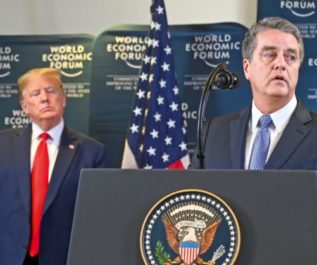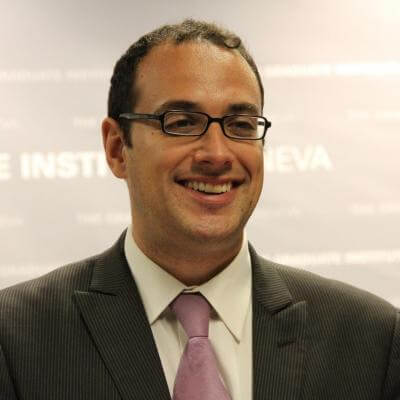US Pressure on the WTO: A Chance to Rebound?
Trade has been topping the news headlines like never before. In most cases, the tone is sombre. Certain pundits go as far as predicting the end of the multilateral trading system. No doubt, there is a crisis. At the same time, we are witnessing more debate, calls for reform and potential for breakthrough than at any time since the WTO’s creation in 1994. “Aggressive unilateralism” by President Trump is one reason for the current state of affairs. The key question is whether the United States is “weaponising” its tariff and market power in a push to reform, or to kill, the multilateral trading system. So far, reform seems to be the endgame. As US Trade Representative Robert Lighthizer put it, “if we didn’t have [the WTO], we’d have to invent it”. A period of “aggressive unilateralism” may be the price to pay for breaking the impasse. Indeed, the very term “aggressive unilateralism” was coined in a book by the same title coedited in 1990 by Columbia University Professor Jadish Bhagwati. In 1994, it eventually spawned the creation of the WTO; In the not too distant future, aggressive unilateralism may turn out to be the catalyst for a WTO 2.0. in the not too distant future, it may turn out to be the catalyst for a WTO 2.0.
AT AN IMPASSE SINCE MORE THAN TEN YEARS
What is the “impasse”? The negotiating arm of the WTO has been in a stalemate for over 10 years, ever since the so-called Doha Development Round, initiated in 2001, stalled. Some WTO deals were concluded (most notably on trade facilitation in 2013) but none of them addressed crucial issues such as the trade-in-agriculture concerns of developing countries, let alone the digital economy or rise of China. The monitoring arm of the WTO, centred around self-notification, is also in trouble: the notification record of most WTO members is dismal. To improve it, with both carrots and sticks, is at the top of the US (and many other countries’) reform agenda. Dispute settlement, finally, was long lauded as one of the WTO functions that truly works. Over time, however, dispute cases lasted years, not months; legal briefs and reports became excessively long and complex; and some countries, first the US (as early as 2001) and later more members, complained about Appellate Body “overreach”, including adjudicators “filling gaps” left open by negotiators. At the end of 2019, when the Appellate Body lost its quorum (because of a US block on appointments), the impasse touched all of the WTO’s branches: legislative, administrative and judicial.
 WTO Director-General Roberto Azevêdo gives a speech as US President Donald Trump looks on at the World Economic Forum in Davos, Switzerland, on 22 January 2020.
WTO Director-General Roberto Azevêdo gives a speech as US President Donald Trump looks on at the World Economic Forum in Davos, Switzerland, on 22 January 2020.What explains the stalemate? Firstly, the WTO makes decisions by consensus of now 164 members. An increasing number of “big players” (such as the EU, the US, China, India, South Africa and Brazil) as well as mounting diversity between members (in particular China’s so-called “state capitalism”) make consensus to update WTO rules extremely difficult. When adjudicators have to decide disputes based on “old” rules, the risk of “filling gaps” (and upsetting some members) increases. Secondly, trade is increasingly mixed up with broader geopolitical battles including national and digital security. This further complicates deal-making and makes third-party dispute settlement highly sensitive. Thirdly, the end of US hegemony and corresponding US leadership (partly) “for free” (epitomised by President Trump’s “America First”) is upending WTO mantras ranging from “diffuse reciprocity” and the most-favoured-nation (MFN) principle (Trump wants “specific reciprocity”, be it in tariffs on cars or access to procurement markets) to special and differential treatment for “developing countries”. The US, but increasingly also the EU and other countries, no longer accept that large trading nations claim special treatment as “developing countries”.
TOWARDS WTO 2.0?
If US pressure, increasingly supported by other members, may be the catalyst for reform, what then could be the contours of a WTO 2.0?
Firstly, WTO rules must be updated to deal with new distortions, in particular elements of China’s “state capitalism” and restrictions as well as level-playing-field challenges linked to the digital economy, data flows, intellectual property and services. The China-US “phase one” deal and trilateral talks between the US, EU and Japan on industrial subsidies are promising for achieving the former; plurilateral talks on e-commerce (which include China) and domestic regulation of services at the WTO may go some way in accomplishing the latter.

Secondly, WTO reform must be guided by shared responsibility (including in limiting domestic support for agriculture) and country commitments based on issue area and topic-specific capacity, not across-the-board bifurcation between “developed” and “developing” countries. Already in the 2013 Trade Facilitation Agreement commitments are country (not group) specific. Recent announcements by Brazil, Korea, Singapore and Taiwan that they will no longer invoke “developing country” benefits in future deals are reason for optimism. The real test will be a new agreement to reduce fisheries subsidies (hopefully concluded in June 2020 at the WTO’s next ministerial) and how “special and differential treatment” is framed there.
Thirdly, the WTO’s legislative and judicial arms must be rebalanced. It would be a mistake to move from consensus to majority decision-making that binds all 164 for anything that adds new legal commitments (countries should only be held against rules they agreed to). Yet, smaller groups of like-minded countries must be allowed to move forward (which may require some revisiting of MFN). More breathing space for negotiations must be complemented with a scale-down in litigation. Automatic dispute settlement must be restored. Yet, it must focus more on speedy resolution and avoiding escalation; less on win/lose litigation and creating “case law”.
Fourthly, and above all, The WTO needs to find a way to be both humble and ambitious. the WTO needs to find a way to be both humble and ambitious. Humble, by scaling down the expectations it creates (the WTO’s mandate is limited) and leaving more room for domestic regulation and trust in domestic checks and balances rather than top-down, Geneva-imposed constraints. Ambitious, by finding a new narrative focused not on “let’s trade more” but on the WTO as stabiliser and interface between a diversity of national systems, promoting fair and sustainable trade whose benefits are spread widely; trade as an instrument at the service of development and environmental imperatives.
Like longstanding regimes on foreign investment and cross-border taxation or competition, the multilateral trading system is in a phase of recalibration, not demise. To address the challenges of a multipolar world, technological innovation and popular demand to “take back control”, the WTO is likely to lose some of its centrality, to the benefit of domestic policymaking and plurilateral and bilateral deals. This is not necessarily a bad thing.
Map based on the data from The Correlates of War Project, “Intergovernmental Organizations (v3)” (for FIGOs) and from Olivier Westerwinter, “Transnational Public-Private Governance Initiatives in World Politics: Introducing a New Dataset” and its electronic supplementary material, in The Review of International Organizations, 2019 (for TGIs).
The data was enriched by the Graduate Institute’s Research Office in Geneva, in collaboration with whybe.ch.
VIDEO | Beatrice Weder di Mauro on the Davos Forum
© The Graduate Institute, Geneva
VIDEO | Nico Krisch on the hierarchy of norms
© The Graduate Institute, Geneva
VIDEO | Stephanie Hofmann and Erna Burai on the evolution of multilateralism
© The Graduate Institute, Geneva.
GRAPH | Overall compliance of G20 member states with 130 summit commitments from 2008 to 2013
Source: G20 Research Group, http://www.g20.utoronto.ca/compliance/dataset.html.
BOX | 633 transnational governance initiatives (TGIs) classified by issue area
- Environment: 243 TGIs, 38,4%
- Climate change: 145 TGIs, 22,9%
- Food and agriculture: 115 TGIs, 18,2%
- Energy: 106 TGIs, 16,7%
- Development: 236 TGIs, 37,3%
- Bank and finance: 25 TGIs, 3,9%
- Regional development: 9 TGIs, 1,4%
- Monetary policy: 1 TGI, 0,2%
- Health: 163 TGIs, 25,8%
- Society: 132 TGIs, 20,9%
- Women: 63 TGIs, 10%
- Science and technology: 60 TGIs, 9,5%
- Technical: 44 TGIs, 0.07%
- Labour: 38 TGIs, 6%
- Education: 34 TGIs, 5,4%
- Culture: 19 TGIs, 3%
- Commerce: 90 TGIs, 14,2%
- Trade: 45 TGIs, 7,1%
- Transport: 35 TGIs, 5,5%
- Tourism: 19 TGIs, 3%
- Human rights: 74 TGIs, 11,7%
- Migration: 6 TGIs, 0,9%
- Crime: 19 TGIs, 3%
- Peace and stability: 15 TGIs, 2,4%
- Soft security: 10 TGIs, 1,6%
- Conflict: 8 TGIs, 1,3%
- Defence: 6 TGIs, 0,9%
- Private security: 3 TGIs, 0,5%
- Nuclear proliferation: 3 TGIs, 0,5%
- Counterterrorism: 1 TGI, 0,2%
- Communication: 28 TGIs, 4,4%
- Transparency: 25 TGIs, 3,9%
- Legal: 22 TGIs, 3,5%
Source: Olivier Westerwinter, “Online Appendix for ‛Transnational Public-Private Governance Initiatives in World Politics: Introducing a New Dataset’”, 30 July 2019, available on https://doi.org/10.1007/s11558-019-09366-w.





